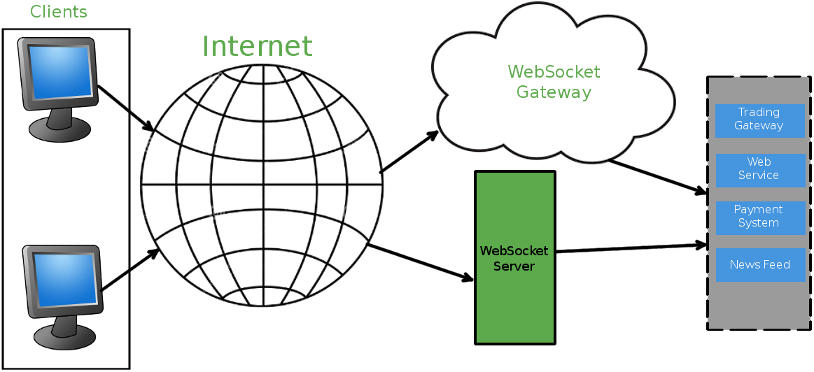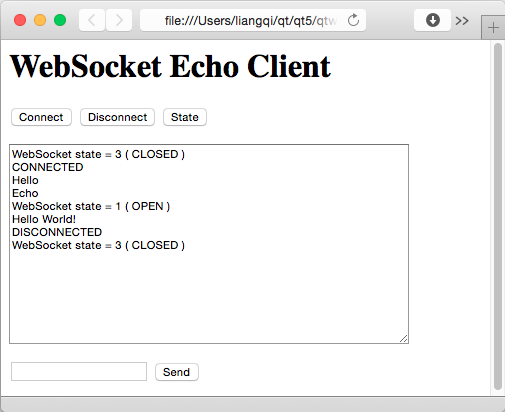
- #QT WEBSOCKET SERVER HOW TO#
- #QT WEBSOCKET SERVER MANUAL#
- #QT WEBSOCKET SERVER CODE#
- #QT WEBSOCKET SERVER ZIP#
The only method that has data in the EventArgs is the OnDataReceived method, the EventArgs ( DataReceivedEventArgs) in this method contains the size of the data and the data itself, these are accessible through properties on the object ( Size and Data). The "sender" in these methods is always the WebSocketConnection object associated with the connection. Static void OnDisconnected(WebSocketConnection sender, EventArgs e)Ĭonsole.WriteLine( " client disconnected") Static void OnDataReceived(WebSocketConnection sender, DataReceivedEventArgs e)

Sender.DataReceived += new DataReceivedEventHandler(OnDataReceived) Sender.Disconnected += new WebSocketDisconnectedEventHandler(OnDisconnected) / static void OnClientConnected(WebSocketConnection sender, EventArgs e)
#QT WEBSOCKET SERVER CODE#
The following is an example of how you could start the server:Ĭopy Code wss.ClientConnected += new ClientConnectedEventHandler(OnClientConnected) The server listens for connections and creates the connection objects upon connection, and the connection objects are used to interact with the clients (sending/receiving data). The WebSocketConnection handles the individual connections. The WebSocketServer is responsible for handling all the client connections and the initial handshaking. The project contains two main classes: WebSocketServer and WebSocketConnection.
#QT WEBSOCKET SERVER HOW TO#
But I'll try to explain how to get it all working. It’s hard to create a ready-made demo application as you need a webserver, a browser and the web socket server to run simultaneously in order for it to work. The code is organized into a couple of classes in a class library, which could be included as a project in your solution or compiled into an assembly. The code is not entirely simple, I'm using a small amount of delegates and lambda expressions, but again, it’s not very hard either. I don't think you would need to be very experienced in working with sockets, but a bit of knowledge shouldn't hurt. This is my motivation for writing this article I'll walk though some of the code for the server and a bit about how to interact with it from JavaScript.

I found a Python and a PHP implementation, but not much about C#. Naturally, I started the development with a Google search this however didn't really help much.
#QT WEBSOCKET SERVER ZIP#
This screenshot is an example of how web sockets could be used (the code is in the attached zip file). As far as I can tell, only Google Chrome supports web sockets at the moment, but I sure hope that it will pick up. So the other day, I decided that I would try to make a small server and test it out on my localhost. Giving us the ability to send data directly to the user, instead of doing something like polling with AJAX requests seems like a very neat idea.

I've been hearing about HTML5 for quite some time now, and I especially liked the idea of web sockets. A lot have changed, and you will need to tweak the code provided, to get it to work. uWS::SSLApp().N.B.: At the point when a wrote this article the standard was still being worked out. You can browse our TypeDoc for a quick overview.
#QT WEBSOCKET SERVER MANUAL#
Start building your Http & WebSocket apps in a swift read the user manual and see examples. µWebSockets should be the obvious, complete starting point for any real-time web project with high demands. :battery: Batteries includedĭesigned around a convenient URL router with wildcard & parameter support - paired with efficient pub/sub features inspired by MQTT. Other companies include Trello, where µWebSockets is serving their 50 million users with real-time board updates. Companies with everything to lose rely on µWebSockets on a daily basis - we power the trading APIs of &, handling volumes of multiple billions of USD every day. We've been fully standards compliant with a perfect Autobahn|Testsuite score since 2016. This allows for rapid scripting of powerful apps, using widespread competence. ΜWebSockets is written entirely in C & C++ but has a seamless integration for Node.js backends.

LGTM scores us flawless A+ from having zero CodeQL alerts and we compile with pedantic warning levels. :closed_lock_with_key: Optimized securityīeing meticulously optimized for speed and memory footprint, µWebSockets is fast enough to do encrypted TLS 1.3 messaging quicker than most alternative servers can do even unencrypted, cleartext messaging.įurthermore, we partake in Google's OSS-Fuzz with a ~95% daily fuzzing coverage with no sanitizer issues. Simple, secure & standards compliant web server for the most demanding of applications.


 0 kommentar(er)
0 kommentar(er)
